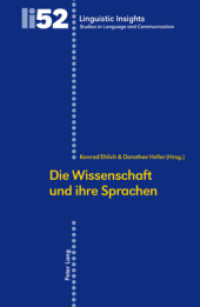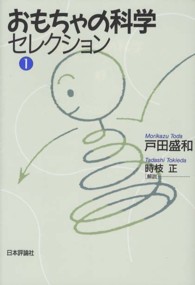Full Description
The Oxford Handbook of Iconicity in Language offers a comprehensive guide to the role that iconicity - resemblance between form and meaning - plays in all modes of languages, on all levels of language, and in all aspects of language. The originally semiotic notion of iconicity has gained widespread attention beyond the field of linguistics; this volume thus brings together research exploring a wide range of topics in iconicity from different perspectives. It explores the history of iconicity and its place in linguistic theory, in particular how the idea of iconicity has developed over time and how it has recently begun to once again influence thinking and theorizing about language. By presenting a very broad spectrum of iconicity, the chapters provide greater recognition of its influence and present a clearer picture of its scope across the languages of the world. They also offer a critical discussion of the notion of iconicity, as its parameters, dimensions, and operationalizations are not always easy to define. The volume will appeal to linguists of all theoretical persuasions, but also to a wider audience outside linguistics proper, including researchers and students in the fields of literature, philosophy, psychology, and cognitive science.
Contents
1: Olga Fischer, Pamela Perniss, and Kimi Akita: Introduction: Iconicity as a general principle underlying language and language behavior
Part I. Foundational issues in iconicity
2: Luca Nobile: Iconicity in classical philosophy: A legacy of prehistoric orality
3: Winfried Nöth: Peirce on icons and iconicity
4: John E. Joseph: Saussure and iconicity: The ghost in the machine?
5: Hendrik De Smet: nalogy and iconicity
6: Sonia Cristofaro: Iconicity in language typology
7: Ludovic De Cuypere: The explanatory power of iconicity in language
8: Thomas Berg: Frequency, variation, and iconicity
Part II. Iconicity in linguistic theorizing
9: Diego Gabriel Krivochen and L'udmila Lacková Bennett: Iconicity and generative grammar
10: Elzbieta Muskat-Tabakowska: Iconicity in cognitive and functional linguistics
11: Bodo Winter, Greg Woodin, and Marcus Perlman: Defining iconicity for the cognitive sciences
12: Vincent M. Colapietro: Embodied mind
Part III. (Morpho)phonology
13: Marcus Perlman: Iconic prosody and its connection to iconic gesture
14: David M. Sidhu: Experimental approaches to sound symbolism
15: Niklas Erben Johansson: Cross-linguistic vocal iconicity
16: Iraide Ibarretxe-Antuñano: The segmentals and suprasegmentals of ideophones
17: Oksana Tkachman: Iconicity in formational properties of signs in sign languages
Part IV. Iconicity in writing systems
18: Dimitrios Meletis: Phonographic writing systems
19: Xinxin Zhao: Logographic writing systems and Chinese characters
20: Sybille Krämer: Notational iconicity
Part V. Morphosyntax
21: Wolfgang U. Dressler and Marianne Kilani-Schoch: Iconicity in word formation
22: Thomas Schwaiger: Reduplication in spoken and signed language
23: Lívia Körtvélyessy: Iconicity in diminutives and augmentatives
24: Carl Börstell: Iconic plurality across modalities
25: Isabeau De Smet and Freek Van de Velde: Iconicity in verbal formation
26: Klaas Willems: Principles of diagrammatic iconicity in language
27: Stela Manova: The iconicity of affix order
28: Anita Slonimska: Iconicity in simultaneous constructions in sign languages
Part VI. Lexis and semantics
29: Janis B. Nuckolls: The enactive iconicity of ideophone semantics
30: Anatoly Liberman: Etymology and folk etymology
31: Silva H. Ladewig: Degrees of iconicity in gestures: From richness to schematicity
32: Michal Szawerna and Neil Cohn: Iconicity in the visual lexicons of comics
Part VII. Discourse
33: James H.-Y. Tai: Iconic sequencing in spoken and signed language
34: Yanna Popova: Iconic and non-iconic aspects of storytelling: Narrative fiction, temporality, and memory
35: Lindsay Ferrara: Iconicity in signed narratives
Part VIII. Iconicity and language learning/ language development
36: Catherine Laing and Beyza Sümer: Iconic bootstrapping for language development: One size does not fit all
37: Gerardo Ortega, Yukari Hirata, and Spencer Kelly: Iconicity in L2 learning
38: Peter Bakker: Iconicity in pidgins and creoles
39: Lotte Meteyard: Effects of iconicity in populations with speech, language, and communication needs
Part IX. Iconicity and language processing
40: Robin L. Thompson and Corrine Occhino: Iconicity in sign language processing: Lexical effects in comprehension and production
41: Bonnie McLean and Yasamin Motamedi: A robustness approach to operationalizations of iconicity
42: Arash Aryani: Iconicity in the mind: Unravelling the cognitive and neural pathways linking sound and meaning
Part X. Iconicity and language evolution and emergence
43: Nicolas Fay and Bradley Walker: Sign iconicity and its contribution to gesture-first theories of language origin
44: Christine Cuskley and Kees Sommer: The evolution of linguistic iconicity and the cross-modal cognitive suite
45: Bencie Woll: Iconicity, multi-modality, and language evolution
46: Maria Flaksman: De-iconization and (re)-iconization: Diachronic aspects of lexical iconicity in spoken languages
47: William J. Herlofsky: De-iconization and re-iconization in signed languages: The case of Japanese sign language
48: Loïs Dona and Marieke Schouwstra: Iconicity in the evolution of language: Computational models and laboratory experiments
49: Brian D. Joseph: Language contact and iconicity
Part XI. Applications of iconicity
50: Federico Gobbo: Iconicity in invented languages
51: Christina Ljungberg: Iconicity in literature
52: John Haiman: The aesthetic motivation of icons: 'We first love things when first we see them painted'
53: Imogen Cohen and Eric Metz: Translation of iconicity: Iconicity of translation








